Flight
for the joy
of Flying
A.I.A.A. Paper #79-0452
© 1979
RWunderground Parachuting Publication
1656 Beechwood Ave.
Fullerton, California 92635
(714) 990 0369
Copyright © 1979 by Madden Travis "Pat" Works, Jr.
AIAA Member
Originally this paper was written for the American Institute of Aeronautics and Astronautics as a part of my presentation to that group's 6th Aerodynamic Decelerator and Balloon Technology Conference. First published by the AIAA as Technical Paper number 79 - 0452, my goal was to open the eyes of my more groundbound peers to the actuallity of today's freefall flight.
Now, these same writings answer parachutings' present need for a good, inexpensive introduction to freefall relative work. As the introduction to the Perris Parachute Center "New Dimensions Flite School", I offer herein a gateway to the fanastic reality of freefall.

Dedicated to "New Dimensions Flite School" and the Perris People
August 1979
© Copyright 1982 by Pat Works
The Traditions of Freefall Relative Work
The dimensions of freefall flight experienced by contemporary parachutists are an indication of the flight capabilities of the human body. Precise body control permits experienced skydivers to participate in group skydiving -- complex patterns and intricate "dance" routines in freefall. This popular form of parachuting is called "relative work". A large number of today's sport parachutists jump from airplanes for the pleasure of group freefall flight. The present level of accomplishment in human freefall and the transferability of freefall techniques to other areas in aeronautics will be explored. A better understanding of the skydiver's skills and concept of flight will improve the design and enhance the marketability of personnel parachutes and related sport parachuting equipment.

Icarus
My purpose is to illustrate the dimensions of flight experienced by contemporary freefall parachutists. Perfect freefall flight control as demonstrated by experienced skydivers indicates the in-flight capabilities of the human body. Precise individual control of one's body permits the completion of complex formations and intricate "dance" routines in freefall.
A primary interest of today's sport parachutist is his or her participation in group freefall. The acts of jumping from the aircraft and deploying a parachute are secondary to the patterns of relative work performed during freefall. A large number of parachutists jump from airplanes for the pleasure of group skydiving. They pursue flight for the joy of flying in relationship with other skydivers.
This presentation will discuss the present level of accomplishment in human freefall flight, concentrating on freefall relative work.
More than 80 percent of parachutists classify themselves as "relative workers". Worldwide, the art of freefall relative work is the most popular aspect of parachuting. Among parachutists, the label "relative worker" correctly applies to all participants from those just past student status who are "cleared for RW (relative work)" to those with many thousands of sport parachuting jumps.
There are various definitions of relative work:
"Relative Work": (from the French "relatif"); n. an art practiced by freefall parachutists performed with perfect body and mind control; the movement of the body in the air so that two or more expert relative workers may all fly into various sequentially executed maneuvers such as a first formation of a "star", followed by a cluster, snowflake, sideflaked donut, caterpillar and so on. Syn. the practice of precision group skydiving (newly labeled 'skydancing'). From Pat Works' text, Parachuting: The Art of Freefall Relative Work. vi, ISBN 0-930438-01-9.
"Relative work is the intentional maneuvering of two or more parachutists in close proximity to one another during freefall. Fast-moving precision freefall relative work is the most rapidly growing aspect of sport parachuting today ... a coordinated balancing act requiring maximum effort from each and every participant ... now an exact aerodynamic science involving 30 or more participants." Excerpted from Dan Poynter's
The Skydiver's Handbook. 94. ISBN 0-9l5516-16-0.
"Relative Work: Aerial maneuvers by two or more freefalling parachutists in order to form a star, etc." From U.S.P.A. PART 10-Definitions: United States Parachute Association Publications, L-0201.
"Relative Work: The cooperative aerial maneuvers executed by two or more jumpers during freefall in order to pass batons, create or 'hookup' various formations, or for air-to-air photography. Such group maneuvering is tricky, due to many variables, and success is normally attained only by the more experienced parachutists."
From Mike Horan's Official Program, 1978 U.S. National Parachuting Championships, "The Language of Skydiving", page 28, June 1978.
The flight skills of skydivers have immediate bearing on the design of sport parachuting equipment. Many of the flight techniques and attitudes used by people in freefall are applicable to other areas in aeronautics and astronautics.
A better understanding of the skydiver's concept of flight will enhance the marketability of personnel parachutes and related sport parachuting equipment. Manufacturers of contemporary personnel parachutes must consider the need of modern skydivers for low-volume, low-weight equipment.
Descending aircraft of all types use gravity as their power in place of their engine. Descending aircraft with power "off" and the human body in freefall perform in much the same manner. The rate of descent in feet per second depends on the angle of attack of the body or aircraft on the wind. For both, a high angle of attack results in a glide (track) while a very low angle of attack is a dive.
Fig. 1 Glide (track)

Fig. 2 Vertical Dive
Both the aircraft and the skydiver's body are controllable in a descent, because both use control surfaces to vary the angle of attack. Both are considered to be flying.
That the body is capable of functioning like an aircraft is not hard to grasp. However, that groups do fly square dances in the sky seems unusual until one understands the underlying theory of freefall relative works (RW). To wit:
RW is done largely with one's imagination.
Skydivers who have a clear picture of how their body reacts to the relative wind can direct its movement realistically by having a good understanding of the body and how it flies, expert skydivers can fly together into any formation they can imagine.
Effortless and naturally correct RW results from the feeling of joy that accompanies near perfect self-flight. The more perfectly the reality of the flight matches the minds-eye benchmark of perfection, or beauty, the greater the joy.
Since one's ability to perceive joy in the roar and buffet of freefall is enhanced by the self-awareness that often accompanies relaxed concentration, full control of the mind is required. For success, this control should be of the Eastern philosophy meditation discipline rather than the frequently debilitating "nerve" which is incorrectly associated with high-speed sports.
As Langewiesche notes, "Angle of Attack is almost literally all there is to flight."2
While skydivers don't have to know it to do RW, it will help then to learn RW. Angle of attack explains all of the freefall relative worker's maneuvers: the various dives, the sinks the types of turns and approaches. It takes the confusion out of maneuvers 1ike the hand track or the reverse arch.
The key fact of freefall relative work is that the body moves by redirecting the air. You deflect the air with your arms, torso and legs. The entire body must deflect air for rapid movement. A body in controlled freefall is nothing but a variable air deflector. In flight, every skydivers' RW body is curved and contoured to be as efficient and effective an inclined plane as we can coordinate it to be.
Or, said another way, from wingtip to wingtip your whole body and being should concentrate on achieving maximum deflection of air.4
Fig. 3 Two Views of a Max Track
A good relative worker's 'feel' for his total body and his almost instinctive ability to handle it right is, on analysis, nothing more than continual awareness of this most important of all flying facts -- the Angle of Attack. That is, the angle at which your whole body and its every flying surface meets the Relative Wind.2
In Jonathan Livirgstoni Seagull's words, As an unlimited idea of freedom, your whole body, from wingtip to wingtip is nothing more than your thought itself. 4
Fig 5. In a track. Converting the speed of a dive into a horizontal swoop
There are four types of relative work:
Non-momentum RW starts at level with zero lateral speed. Movement is generated from a standstill. There is no velocity left over from the descent dive (track). Experts at it literally seem to dance on columns of air beneath them.
In momentum RW one never stops or slows down; track (dive) generated velocity is maintained and redirected to put the body where it is supposed to be relative to the other freefallers.
When terminal velocity is reached, skydivers have a relatively constant rate of fall that tends to be uniform with the group with which they are flying. Most discrepancies due to body size can be compensated for by jumpsuit or body position.
When many of us think of "falling stable" we usually have as a reference the two positions explained by Russ Gunby5 as "the basic stable" and the "French Frog".
Fig. 6 Basic Stable
Fig. 7 French Frog
These positions are rigid; the arms and legs are held down against the Relative Wind. The idea that rigidity is d necessity in the stable freefall position began to dissolve with the advancement of freefall RW which led to my introduction of the RW Stable position.
The principal idea behind the RW Stable position is that it is not a wind-deflecting position at all. The arms and legs are not held out into the wind to act like outriggers on a canoe for the body, but instead they are consciously allowed to blow back behind the body and provide stabilization like the feathers on a badminton bird or an arrow. The arms and legs and head and torso are brought out of relaxation and into play only when movement is desired.1
Fig. 8 RW Stable
There are different modes of moving for specific situations -- some are obvious, some are fancy. Consider dives alone: a skydiver may descend in a vertical dive, a vertical no-lift dive, or a delta.
All together I figure there are five major modes of movement dives, glides, braking, RW turns, and recovery maneuvers.

Fig. 10 DELTA -- Body has high Angle of Attack and develops considerable lift resulting in horizontal movement.

Fig. 11 VERTICAL DIVE -- Body points straight down but flight path is not straight down. Body has some Angle of Attack, some lift.

Fig. 12 NO-LIFT DIVE -- Body has no Angle of Attack, no lift. Body is slightly inverted. Flight path is straight down.
In its least efficient form, the track is simply a delta... medium horizontal speed and a fairly high descent speed.
The fastest mode of horizontal RW flying is the max-track. The max-track is a track modified by the jumper to produce greater horizontal speed, or more accurately, the greatest distance covered on the horizontal plan per foot of fall.
The hand track, another glide maneuver, is initiated from a stable position. It is the key maneuver of non-momentum relative work. The hand track is probably the "original" relative work maneuver because it is initiated from a dead-still stop with no residual velocity left over from the descent track.
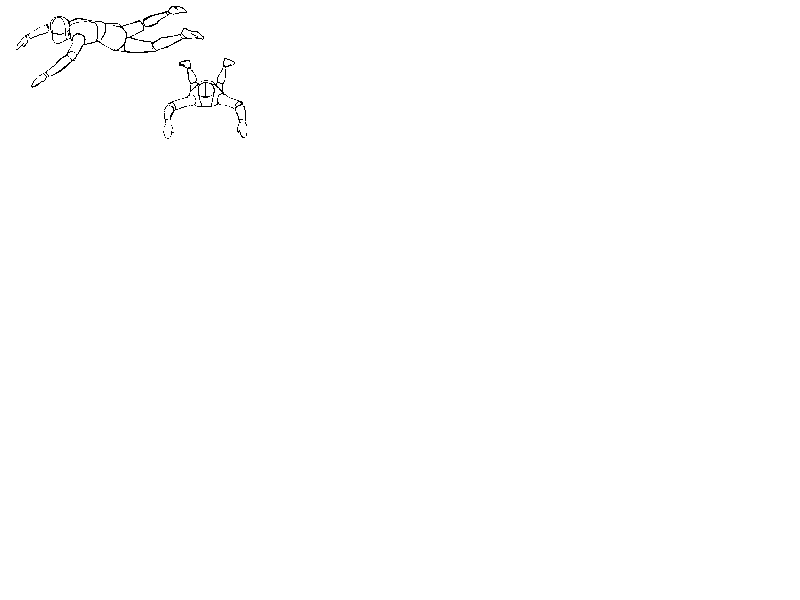
Fig 13 Hand Track
Backward and sideways movement can be accomplished without a change of heading by throwing out the arms or an arm and leg to deflect air and glide in the desired direction.
RW turns effect a change in direction of movement as opposed to a simple change of heading. turning requires the skydiver's constant awareness of his or her Angle of Attack and of the Relative wind. This involves using the whole body "from wingtip to wingtip" to move.
Moving upward in relation to the target formation requires extreme muscle tension.
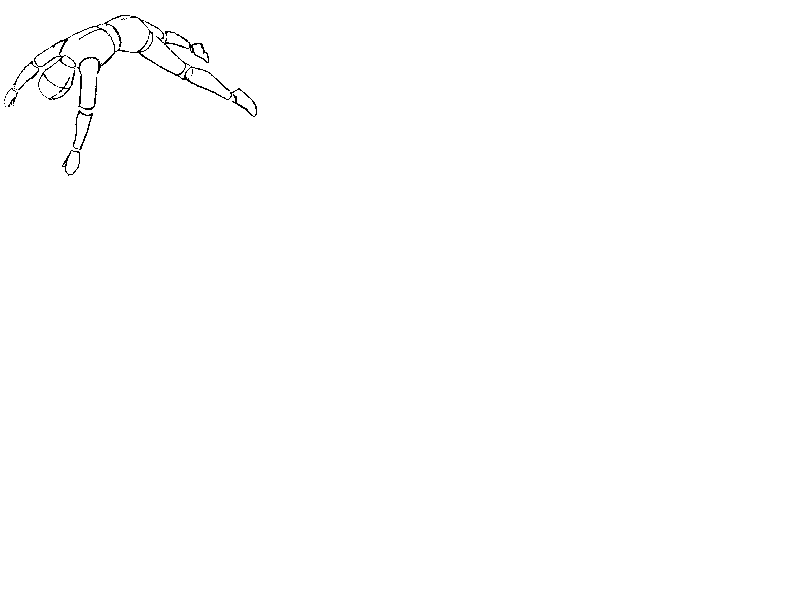
Fig. 14 Recovery Position
There are three basic approach angles from the aircraft to the target formation used in momentum RW.
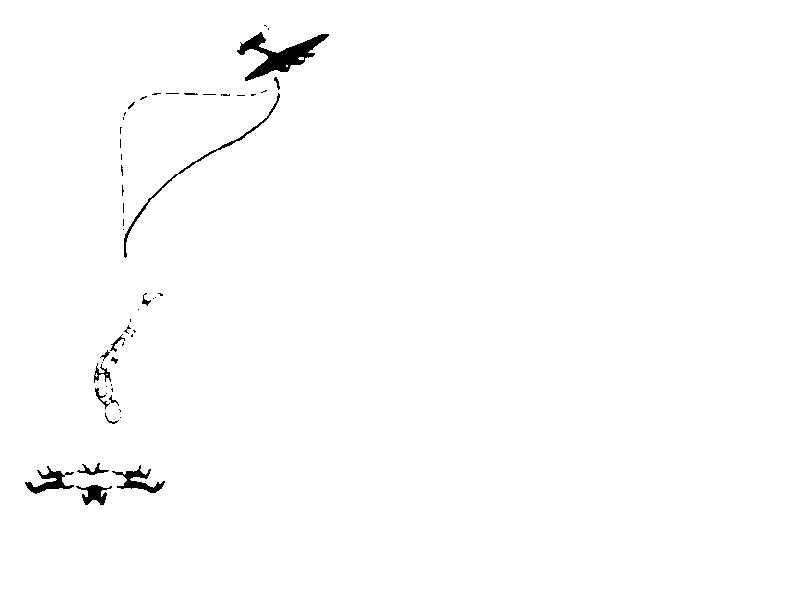
All maneuvers discussed thus far are directed toward a smooth entry into the target formation, or "docking" with other skydivers. This instant of contact must be precisely executed.

The Jewel
The realization that "....YOUR PARACHUTE GEAR IS PART OF THE AIRPLANE THAT IS YOUR BODY....... 1 has had significant impact on the design philosophy of parachute equipment used by today's sport jumper. With the dawn of this realization, design philosophy quickly shifted from "make it safe and reliable" to "make it small and light."
To be rid of the hassle and bulkiness of spring-type pilot chutes, most jumpers hand deploy the pilot chute on their main canopy. This do-ityourself pilot chute deployment offers the feeling that openings have become more controllable by the jumper.
Likewise, the standard ripcord handle has been replaced by softer "puds", usually made of cloth or light-weight plastic. Accessibility of the main ripcord handle is now considered secondary to protecting the wearer from an accidental opening.
The older "Capewell" canopy release, which was known to occasionally hang up and fail to release, has been generally replaced with single-point release systems which also have been known to occasionally hang up and fail to release. We find ourselves in a situation where most of us use
equipment which can be difficult to operate in practice. Today, many ripcord handles are lcoated out of sight, and so must be found by the sense of feel. Trying to find your ripcord fast in a panic-pull situation can be difficult. The high speed pilot-chute-in-tow malfunction, unheard of until fairly recently, is also a problem characteristic of non-spring pilot chute deployments.
However, the benefits that small and light tandem parachute systems offer the relative worker outweigh these few problems. The reduced mass and bulk of our lightweight systems makes freefall flight easier to accomplish. By using lightweight gear, we can do better relative work easier and more comfortably than ever before.
Clearly the jumpsuit is the most important part of the relative worker's equipment. Today's jumpsuit has evolved into a "flightsuit". Extra material in the arm, leg and "wing" area of jumpsuits provides greater control surfaces for more controlled flight.
Generally speaking, today's oversized flightsuits make precision relative work more difficult to accomplish. The actual aerodynamics of the jumpsuit are often frequently ignored in favor of adding more underarm, or wing area, material. The result is a jumpsuit wing-size war.... an undeclared contest between jumpers where flight characteristics are sacrificed for a slower rate of fall.
Analysis of slow-motion films of large formations in freefall clearly reveals the cause of mild-flight problems experienced by most wearers of large flightsuits. On many of the approaches, a wild, uncontrolled flapping of the wing area is noticeable. Flyers who experience this excessive flutter and flap report that it inhibits smooth flying by randomly distributing strong jets of unfocused windstream.
The bucking, snapping and misdirected flapping of a double set of sequential wings sometimes deflects the air it spills in ways that make it harder than necessary to fly. It forces a reaction which results in a typical body position seen often in films of large formations (i.e., hanging from armpits to keep the center of gravity low to avoid severe buffeting).
Disruptive flapping and resulting loss of control requires awkward cross control flying techniques, i.e., extending the left arm while grabbing the formation with the right hand to compensate for unwanted float on reaching.
Controlling unwanted float and misdirected wing flap on jumpsuits can result in significant improvement in the wearers' flight. By slightly reducing the wing size and adding a control enhancer to cancel wing flap, better forward drive and greater flight control can be realized.
Several parachutists, including the author, are working on wing area engineering to clean up the airflow from the wing. The uncontrolled flapping of approximately 500 square inches of wing extensions reflects the abrupt and random eddies of wind blast as they spill from the wing. These eddies of wind may add unwanted float or bobble to flight approaches.
By smoothing out the airflow so that it can be controlled and directed by the wearer's movements, flying is easier. By cleaning up the air that spills from the back edge of the wing, the wing itself becomes more responsive to control by the wearer of the jumpsuit. For example, in my design a formed trailing wing edge controls the wing's effective size and airflow direction. The trailing edge is further controlled by a springy brace-type construction which acts as a pneumatic anchor to the high pressure "solid" armpit wing area where tension is concentrated.
In other words, the trailing edge is like a torsion bar which a thin, flexible batten connects to the underarm area (i.e., a high flap area is tied to a no-flap area). The construction is similar to putting shock absorbers on a car. Gross and unwieldy up-down wing oscillations are smoothed out and absorbed.
Parachuting shares much with ballet, bull fighting, motorcycle racing and mountain climbing.
Each of those sports has a common element pictorial perceptions of "perfect" motion. This poetry-in-movement is performed and appreciated as art is, with the art from being movement perfectl orchestrated to the music of the environment.6
In parachuting, perfect freefall flight is the cognitive goal of relative workers. Perfect freefall flight is performed by those who understand that the paths of fun and beauty lead to success and fulfillment.
Though a Western sport, the art of freefall relative work has a subtle Eastern character. This is the mystical element of linked mind and body movement. By mastering the mind, one's bodily movements are mastered; perfect speed of flight is being There; a skydance has a rhythm which you mesh to as you dance with the wind; you can easily fly anything you can imagine; imagining your flight to be perfect and then following your imagination with your body gives pleasant results.
While there can be no rules for progressive relative work, there are some steps to consider. Many others who are flying, the same path have contributed to this knowledge. The specific guidance to perfect flight follows.
There are two aspects of freefall flight; the action of the flight and the inner direction from the mind. If the inner direction of the mind is faulty and has as its goal completion of formation or speed, the resulting action of the flyer will be inferior.
The proper goal of flight is to achieve perfect flight. Directing one's actions with the goal of perfecting flight results in the very best of skydives.
Overflights of anxiety about how the dive will go produces flight problems by robbing attention and energy from the act of flying. In RW flight, the participant must act on the exact moment of each movement and in real time joy. In perfect flight, later never exists and the past is gone away forever so that every part of you is centered on the now of each moment.7
Everything that moves has its own flow; rivers, streams, wind currents, dances and skydives all flow at their own rate. You can never hurry up this rate of flow without disrupting it and getting out of sequence with your action. To ignore flow on the dance floor brings instant ridicule. To ignore flow is folly.
In skydiving, one strives to be in position at the exact time that position becomes stable. Without hindering another or moving the formation, perfect flight is achieved by being There on time.
That's why perfect speed isn't flying faster or slower. Flying faster and slower are limits, and perfect flight has no limits. Perfect speed is being there. Thus, successful skydivers should flow with the dive so as to arrive in position in smooth, natural unison.
Being able to flow depends on awareness. Awareness is understanding exactly what one's body is doing in relation to the other freefallers.8 Awareness is being relaxed enough to select the proper clues to guide one's flight. Awareness is letting imagination pick the perfect flight path while overseeing it with intelligence.
Flight should be pictured to be as perfect as beauty of movement allows.
Ref. I.D.
4 - Bach, Richard. Jonathan Livingston Seagull. New York, 1970.
7 - Evans-Wentz, W. Y. ed. The Tibetan Book of the Great Liberation. London, 1954.
5 - Gunby, Russ. Sport Parachuting. New York, 1975.
8 - Jenkinson, Denis. The Racing Driver. Massachusetts, 1960.
2 - Langewiesche, Wolfgang. Stick and Rudder. ISBN; 07-036240-8, 1944.
3 - Prabhavananda, Swami and Christopher Isherwood trans Bhagavad-Gita. New York, 1944.
6 - Works, Pat and Jan Works, ed. Parachuting: United We Fall. ISBN: 0-930438-02-7, 1979.
1 - Works, Pat. Parachuting: The Art of Freefall Relative Work. ISBN: 0-93043801-9 1975.
These basic units, or combinations of them, make up all sequential dives. The ability to perform fast, stable, reliable bases is, of course, the first prerequisite to becoming a viable sequential group. A group beginning sequential relative work will usually build its first formations by repeating the same base unit in some logical pattern.Examples are:
STARS
PODS
Diamond - A maneuver or 4, 9, 16, 25, 36... jumpers with an overall diamond shape:

Dock - Flying 2 or more seperate formations (each containing 2 or more people) together to form another maneuver:
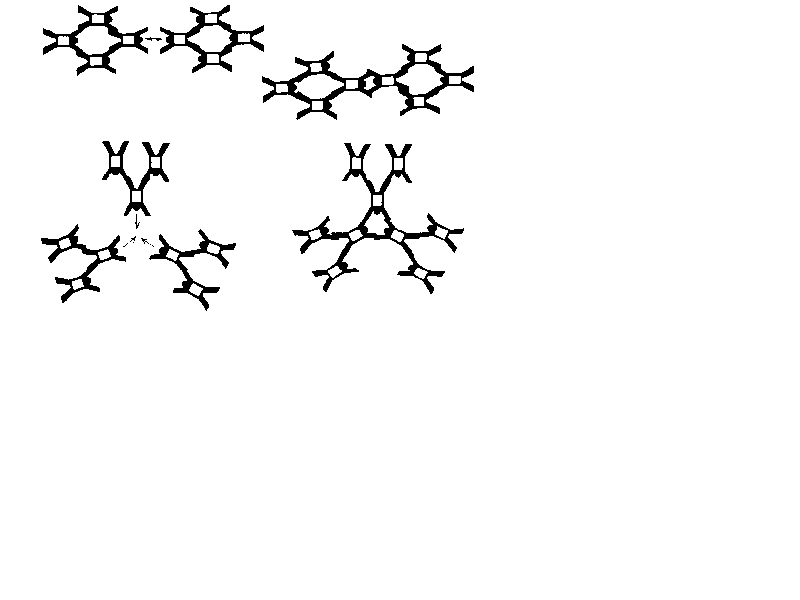
Flake - The outer portion of a maneuver, similar to a cluster. The jumper(s) hook-up to one person's legs, or, in the case of a donut flake, to the outside leg of one jumper and the outside hand of another, or, in a cluster-flake, between the legs of two jumpers:

Snowflake

Cluster-flake

CLUSTERS

FLAKES

CONNECTORS

STAIRSTEPS
WEDGES

DIAMONDS

Donut-flake

Float - What most maneuvers, especially large ones, do.
Floaters - It's a good idea to use floaters on maneuver loads: those who will exit the aircraft ahead of the base-pin and enter the formation on the back side - try it, you'll like it.
Fold-Out - A member of a manerver who will hold on with one hand, or be held in by a leg, and rotate around that grip to either an open slot or rotate into another position in the formation.
In-Out - A star of even-numbered people, half of whom are facing the center and have the commanding grips; half of whom are facing out and are being held by their legs:

Maneuver - More commonly, a formation, where the jumpers connect in any combination of grips to produce a geometric pattern.
Pod - 2 or 3 jumpers connected to form an additional section on the outside of a maneuver, on the legs of a person in the base formation:

Point - The front man on a wedge or diamond:
Opposed - Members in the formation may be facing each other directly:

Sequential - A series of maneuvers completed in one jump, effected thru grip changes, grip breaks and flying, or both.
Spider - A 5-man base unit for wedges, diamonds, or anything you like:

Star - a round formation or maneuver.
Stairsteps - 2 jumpers hooked-up hand to opposing leg to form an offset cat:

Swoop - Time between your exit and entry to the maneuver.
Tail - The back or slot man on a diamond:

Tip - The corner men on a wedge or hourglass:
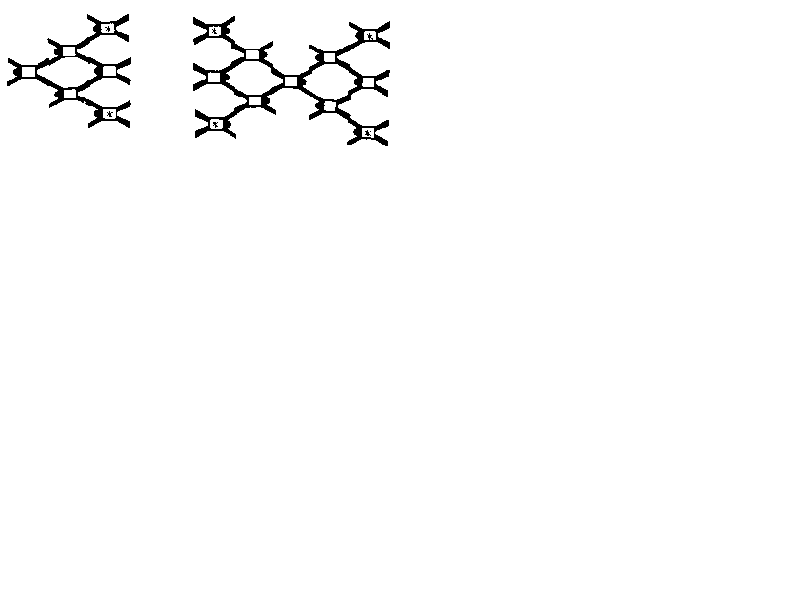
Wedge - 3, 6, 10, 15, 21, 28... jumpers forming a triangle or wedge shape:
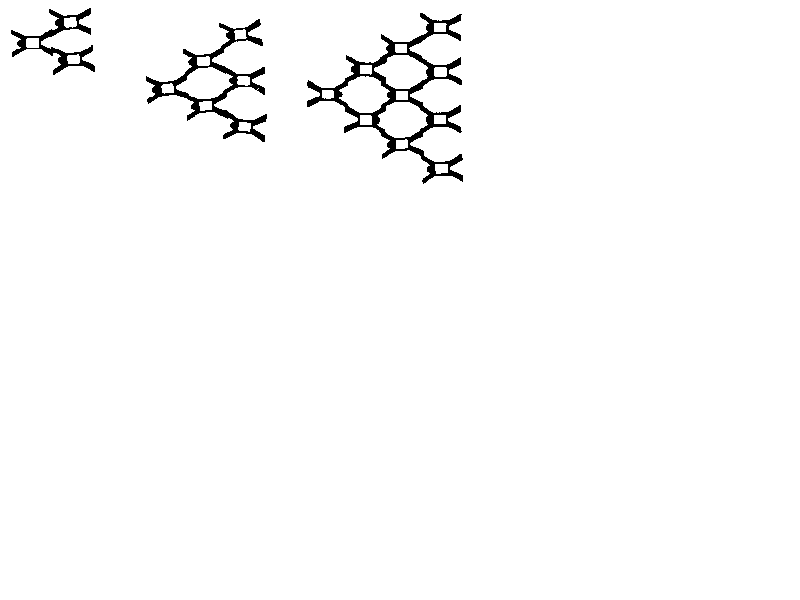
Wing - The side men on a diamond:

16-CLUSTER-FLAKE TO QUADRA-DIAMONDS:
